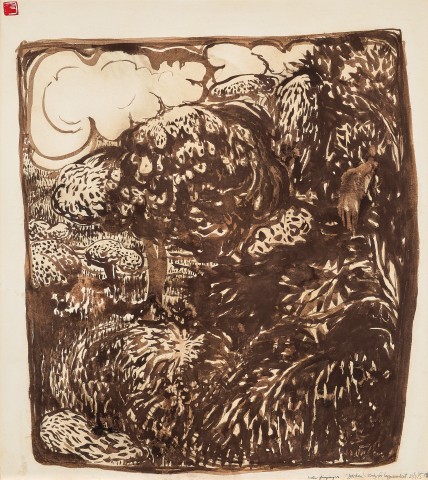GARDEN, 1975
BRETT WHITELEY
brush and sepia ink on paper
84.5 x 75.0 cm
stamped lower right in black ink with artist’s monogram
stamped upper left in red ink with artist’s chop
inscribed and dated lower right: further glimpsing in ‘Garden’ – study for large woodcut 21/7/75
Bonython Art Gallery, Sydney
Robin Gibson Gallery, Sydney
Company collection, Victoria
Sotheby’s, Sydney, 7 May 2007, lot 73
Company collection, New South Wales
Private collection, Melbourne
Private collection, New South Wales, acquired in 2009
Brett Whiteley: Thirty six looks at four sights on three themes: recent paintings, drawings and carvings, Bonython Art Gallery, Sydney, 24 October – 15 November 1975, cat. 11 (as ‘The Garden’)
Sutherland, K., Brett Whiteley: Catalogue Raisonné, Schwartz Publishing, Melbourne, 2020, cat. 141.75, vol.3, p. 302 (illus.), vol. 7, p. 336
The Blue Garden, 1975, oil and watercolour on canvas, 75.5 x 61.0 cm, formerly in the collection of Dr Peter Elliott, Sydney
Drawing was the cornerstone of Brett Whiteley’s artistic practice, and his diverse works on paper informed and supported the major paintings and sculptures he produced throughout his lifetime, often exploring alternate compositional emphases. Garden, 1975 is a large drawing in sepia ink of a neighbouring garden viewed from Whiteley’s home in Sydney’s Lavender Bay, ostensibly a design for a future woodcut that was never executed.1 Garden was first exhibited at Bonython Galleries in Sydney, in an exhibition called ‘Thirty Six Looks at Four Sights on Three Themes’, alongside other large works all drawn with brush and ink on paper. Garden was the only one painted using the warm tones of sepia ink.
In 1975, Brett Whiteley moved from his studio space in Waverton to a house on the foreshore of Sydney Harbour in Lavender Bay. This now famous house’s panoramic views on to the harbour provided the artist with a new format for artworks, which he called ‘windowscapes’, and through which he could claim this patch of Sydney as his own private domain. These close views of verdant gardens, atmospheric rain-soaked harbour views, and stepped rows of rooftops, provided Whiteley with a restorative change of pace. Far from the political and philosophical angst of his earlier works, Nancy Borlase noted, Whiteley’s works from this period were imbued with contemplative quality, ‘a fresh appraisal of nature, reflecting a domestic tranquillity and a lifestyle in harmony with the bay.’2 Whiteley described this new impetus as ‘recording… points of optical ecstasy, where romanticism and optimism overshadow any form of menace and foreboding’.3 Described by the artist within the Bonython exhibition catalogue as ‘immediate landscapes’, these ‘Window’ paintings used the structure of a window frame to isolate only a section of the spectacular view. Whiteley’s flattened perspective and a graphic stylisation gave the finished image the appearance of a patterned screen, reminiscent of the Asian calligraphic art he so admired.
Whiteley’s introspective focus was informed by his admiration for Zen Buddhist philosophy and the meditative process of brush-and-ink calligraphy. Whiteley described Zen as the ‘theology of drawing’4 and viewed this ancient medium as ‘the great unalterable’ 5, its application requiring the utmost confidence and mindfulness. The resulting works on paper bear a spontaneous and fluid quality, swirling with watery primordial and metamorphic potential. Garden, 1975 is a dense and luxuriant view of the leafy environs of Lavender Bay. Compressed into a single plane, the brick confines of this Eden are barely discernible amongst the stippled brushstrokes for each blade of grass and tree leaves of the foreground. In contrast to the ultramarine nocturne of its related painting, Blue Garden, Whiteley uses the white paper to evoke strong sunlight hitting the trees’ canopies. Presenting a lyrical tableau of crowded abundance beneath whimsical billowing clouds, Whiteley’s Garden captures a fleeting vision, and evokes the possibility of contemplative peace within his idyllic environs.
1. Sutherland, K., Brett Whiteley: Catalogue Raisonné, Schwartz Publishing, Melbourne, 2020, cat. 141.75, vol. 7, p. 336
2. Borlase, N., ‘An Unexpected Whiteley’, The Bulletin, Sydney, 23 November 1974, p. 57
3. McGrath, S., Brett Whiteley, Bay Books, Sydney, 1979, p. 168
4. Ibid
5. Drawing and How to Get it On, 1975, illus. in McGrath, ibid., p. 183
LUCIE REEVES-SMITH
